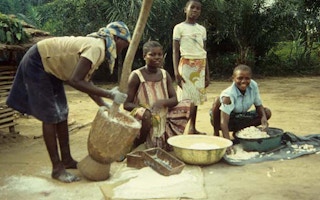Global food markets will likely remain “generally well balanced” in the year ahead, as prices for most internationally-traded agricultural commodities are relatively low and stable, FAO said today.
The benign outlook, especially for staple grains, is poised to lower the world food import bill to a six-year low, according to the Food Outlook.
Record global production forecasts for this year’s wheat and rice harvests, along with rebounding maize output, are helping keep inventories ample and prices low. Worldwide cereal production in 2016 should rise 2 569 million tonnes, up 1.5 per cent from the previous year and enough to further boost existing inventories.
The value of total food imports is expected to fall 11 per cent in U.S. dollar terms in 2016 to 1.168 trillion, as lower bills for livestock products and cereal-based foodstuffs more than offset higher bills for fish, fruit and vegetables, oils and particularly sugar. However, the decline is expected to be slower for economically more vulnerable nations, many of which have depreciating local currencies.
Bumper crops
FAO raised its forecast for global wheat production to 742.4 million tonnes, led by increases in India, the U.S. and the Russian Federation - which is poised to overtake the European Union as the grain’s largest exporter. Total wheat utilisation is projected to reach 730.5 million tonnes, including a big jump in use of lower-quality wheat for animal rations.
Global rice production is predicted to expand for the first time in three years, increasing 1.3 per cent to an all-time high of 497.8 million tonnes, buoyed by abundant monsoon rains over Asia and sizable increases in Africa. Coarse grain output is seen rising 1.8 per cent on the year, buoyed by record crops in the U.S., Argentina and India.
Cereal prices are drifting lower on the backs of the expected hefty supply. Wheat and maize futures on the Chicago Board of Trade have both dropped more than 16 per cent since the start of the year, while quoted rice prices are at their lowest level since early 2008.
Production of cassava, a dietary mainstay in Africa where per capita consumption is above 100 kilograms annually, is also projected to grow 2.6 per cent this year to 288 million tonnes. However, China’s shift to drawing down its maize stockpile for domestic industry and feed has curbed international prices and trade flows for cassava.
Soybeans and other oilcrops could reach an all-time production high this year, thanks to record US yields, although demand is expected to grow even faster. In the livestock sector, dairy markets are also expected to return to general balance in 2016 after a long period of excess supply, but tightening milk availabilities in the EU triggered the largest monthly rise in dairy prices in many years.
Stagnant world meat output in 2016, twinned with rising international demand for pigmeat and poultry, especially from East Asian markets, continues to lend support to meat prices.
Global fish production, meanwhile, is forecast to expand by a below-trend 1.8 per cent this year to 174 million tonnes, as aquaculture output is expected to expand by 5 per cent and wild-caught fish output to decline by 0.9 per cent, due in part to El Nino’s impact on Pacific sardines, anchovetas and squid.
Food Price Index
The FAO Food Price Index, also released today, averaged 170.9 points in September, up 2.9 per cent from August and 10 per cent from a year earlier.
The increase was driven by a 13.8 per cent monthly jump in the FAO Dairy Price Index, partly as a result of a sharp jump in butter prices benefiting exporters in the EU, where dairy output is declining.
The FAO Sugar Price Index rose 6.7 per cent from August on the back of unfavorable weather in the Centre South main producing region in Brazil.
Palm oil prices also rose, helped by low stock levels in both exporting and importing countries, as did those of soy and rapeseed oil, lifting the FAO Vegetable Oil Price Index by 2.9 per cent for the month.
The FAO Meat Price Index was unchanged from August.
The FAO Cereal Price Index, meanwhile, slipped 1.9 per cent from the previous month and is 8.9 per cent below its year-earlier level.
The FAO Food Price Index is a trade-weighted index tracking international market prices for the five key commodity groups. Its current level is the highest since March 2015. The sub-index for cereals is now at its lowest in a decade in deflated terms.










